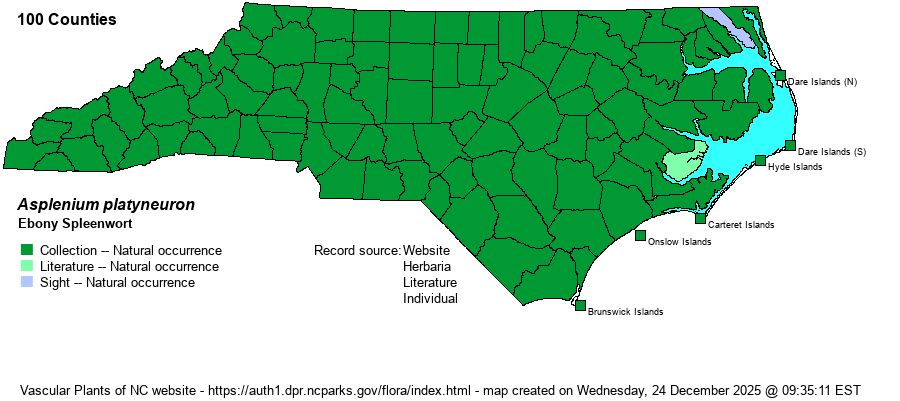| Author | (L.) Britton, Sterns, & Poggenburg | |
| Distribution | Occurs statewide, found in every county, even on the barrier islands. Pamlico County--are you there?
This is the most widespread Eastern species of fern, present in essentially every state south to southern FL and central TX. It ranges north into eastern Canada.
| |
| Abundance | Very common and widespread, found in more sites in NC than any other fern species. | |
| Habitat | This species grows in a great array of forests and old fields and edges. It prefers pine and mixed forests, both dry or damp; it also grows in rocky woods, around rock outcrops (even in crevices of many rock types), as well as in powerline clearings, wooded margins, yards, and many other shaded to partly shaded places. Soil pH and rock types are highly varied. |
| Phenology | Fruits from April to October. | |
| Identification | This is the most often encountered fern in the state, but as it is rather small, it can be overlooked by the layperson in favor of larger and more obvious species such as Christmas Fern (Polystichum acrostichoides) or Cinnamon Fern (Osmundastrum cinnamomeum). Several evergreen fronds grow in a clump, and each plant has both fertile fronds and sterile fronds. The fertile fronds are erect and taller, with a short but shining brown stipe often just 1 inch long, and a long (for an Asplenium) blade that is narrowly oblong, about 10-12 inches tall but just 1.5-2 inches wide -- it is pinnately cut. The several dozen pairs of pinnae are alternate, narrowly oblong to about 3/4-inch long and 1/5-inch wide, with a small but noticeable basal lobe. The sori are very numerous under each pinnae, diagonal to the midrib. The sterile fronds are smaller than the fertile ones and often lean or are ascending, and they reach only about 4-5 inches long at most. (One might wonder why any fern would have sterile fronds smaller than the fertile ones; why have them at all?). This is the Asplenium to which any other contenders should first be compared; frankly, no other ferns should be confused with this highly familiar species. However, it does grow at times on vertical rock faces, such as marl or limestone, and could be confused with A. resiliens or A. heteroresiliens if you are not careful. Normally, Ebony Spleenwort has a larger and more obvious basal lobe on each pinna than present on those rare species. | |
| Taxonomic Comments | Very robust plants, mostly from the Coastal Plain, have been treated by some authors as var. bacculum-rubrum, but supposed differences are only a matter of size and may simply be clinal.
| |
| Other Common Name(s) | None | |
| State Rank | S5 | |
| Global Rank | G5 | |
| State Status | | |
| US Status | | |
| USACE-agcp | FACU link |
| USACE-emp | FACU link |

